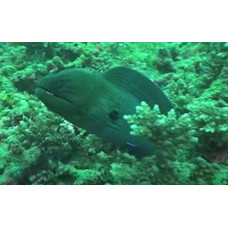Latin name
Gymnothorax javanicus
Other names
Gymnothorax javanicus
Identification
The body is compressed from the sides and covered with a layer of mucus, which allows the animal to glide and enter small caves and other shelters safely and easily, and protects it from mechanical damage and parasites. A distinctive feature of this species is its relatively wide jaws. The huge mouth is dotted with sharp, fang-like teeth on two pairs of jaws - the second pair is located deep in the throat, but can be extended to grab prey and drag it down the esophagus.
Features of fish fins
Dorsal spines (total): 0; Anal spines: 0. The dorsal fin literally covers the entire body, giving the fish the ability to reach very high speeds without losing maneuverability.
Fish colouring
Juveniles of this species are yellow-brown with numerous small black spots. The camouflage of adults is similar to that of a leopard. The head, upper body and fins are yellow-brown with numerous small black spots of varying sizes. The belly is colorless.
Distribution
Widespread throughout the tropical Indo-Pacific: in the Red Sea and off the coast of East Africa, off the Marquesas Islands and Oeno Atoll (Pitcairn Group), north to the Ryukyu Archipelago and Hawaii, south to New Caledonia and the Tubuai Islands.
Habitat
This species is not found deeper than 50 meters. This species prefers clear lagoons and slopes of reefs facing the sea. Often found along deep cliffs and slopes, it leads a benthic lifestyle. Juveniles are more secretive and live in the intertidal zone of shallow coral reefs.
Size
The largest member of the family by weight and the second longest after Strophidon sathete (up to 4 m). Reaches 3 m and weights up to 30 kg.
Behavior
They are solitary and mainly active at night. Sometimes it hunts during the day, cooperating with Plectropomus pessuliferus: the perch helps the moray to find hidden fish, and the moray from time to time gives the caught prey to the perch.
Food and feeding habits
Feeds on any fish, cephalopod or large crustacean it can catch.
Reproduction
Observations of fish behavior prior to spawning showed a pair intertwined on the bottom near the reef. Life expectancy is about 36 years.
Fishing
Not of interest to anglers because of its poison.
Relationship with a person
There have been reports of the presence of ciguatoxin.
| Classification | |
| Phylum | Chordata |
| Class | Actinopterygii |
| Squad | Anguilliformes |
| Family | Muraenidae |
| Genus | Gymnothorax |
| Species | G. javanicus |
| Features | |
| Conservation status | Least Concern |
| Habitat | Pelagic |
| Life span, years | 36 |
| Maximum body weight, kg | 30 |
| Maximum length, cm | 300 |
| Sailing speed, m/s | No information |
| Threat to people | Edible |
| Way of eating | Predator |
Giant moray
Tags: giant moray



